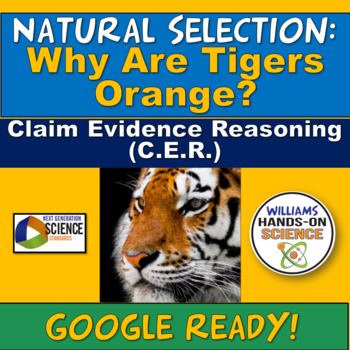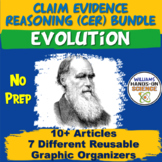NGSS Evolution Natural Selection Claim Evidence Reasoning Why Are Tigers Orange?
- Zip
Also included in
- Students learn about various current events and discoveries in Evolution through Claim Evidence Reasoning. You get 10+, 30-40 minute NO PREP resources that are great for English Language Arts, Sub Plans, reinforcing content, application of content to the real world and the NGSS Science and EngineeriPrice $35.00Original Price $61.00Save $26.00
Description
Students learn that Tigers are orange because of the way their prey sees them through a C.E.R. (Claim Evidence Reasoning) graphic organizer. This is great for getting your students to explain phenomena in a meaningful way and it allows you as the instructor to adequately assess their understanding of concepts. The students figure out what the "Claim" is in the article, they then use data that supports the claim in the "Evidence" section, draw visual evidence and then explain why the evidence supports the claim in the "Reasoning" section.
The article has the following concepts:
Evolution
Natural Selection
Predator
Prey
Traits
Species
Camouflage
Biomolecular Structures
Take a look at my CER Mega bundle!
Take a look at more Evolution CER’s:
NGSS LS4.B LS4.C Natural Selection Adaptations 5E Distance Learning Google Ready
Evolution LS4.A LS4.B LS4.C Google Ready Growing Bundle Natural Selection
Natural Selection NGSS LS4.B PhET Computer Simulation Google Ready
Distance Learning LS3.A LS3.B Variation of Traits Science Doodle PowerPoint
This is great for a current event, sub plan, homework, critical thinking, scaffolding and/or reinforcement of concepts!
You get a CER graphic organizer, an editable key, the article, tips for CER, a link to make it Google Ready, and the link to the website in the article.
NGSS Standards:
Middle School:
Construct an explanation based on evidence that describes how genetic variations of traits in a population increase some individuals’ probability of surviving and reproducing in a specific environment. MS-LS4-4
LS4.B: Natural Selection
Natural selection leads to the predominance of certain traits in a population, and the suppression of others. (MS-LS4-4)
LS4.C: Adaptation
Adaptation by natural selection acting over generations is one important process by which species change over time in response to changes in environmental conditions. Traits that support successful survival and reproduction in the new environment become more common; those that do not become less common. Thus, the distribution of traits in a population changes. (MS-LS4-6)
High School:
LS3.B: Variation of Traits
Environmental factors can also cause mutations in genes, and viable mutations are inherited. (HS-LS3-2)
Environmental factors also affect expression of traits, and hence affect the probability of occurrences of traits in a population. Thus the variation and distribution of traits observed depends on both genetic and environmental factors. (HS-LS3-2), (HS-LS3-3)
SEP's Asking Questions and Defining Problem:
Students at any grade level should be able to ask questions of each other about the texts they read, the features of the phenomena they observe, and the conclusions they draw from their models or scientific investigations.
Engaging in Argument from Evidence:
In 9–12 builds on K–8 experiences and progresses to using appropriate and sufficient evidence and scientific reasoning to defend and critique claims and explanations about the natural and designed world(s). Arguments may also come from current scientific or historical episodes in science.
CCC's: Patterns
Observed patterns of forms and events guide organization and classification, and they prompt questions about relationships and the factors that influence them.
Cause and Effect
Empirical evidence is required to differentiate between cause and correlation and make claims about specific causes and effects.
TERMS OF USE
• All rights reserved by Williams Hands On Science, Inc.
• This product is to be used by the original purchaser only.
• Intended for classroom and personal use only.
• Copying for more than one teacher, classroom, department, school, or school system is prohibited.
• This product may not be distributed or displayed digitally for public view.
• Failure to comply is a copyright infringement and a violation of the Digital Millennium Copyright Act (DMCA).
If there are any errors or questions, please contact me through TpT or email me at:
williamshandsonscience@gmail.com
Thank you for taking a look!
Please follow me on TpT for new products and check me out on Instagram for my products in action!
https://www.instagram.com/williams_hands_on_science/






